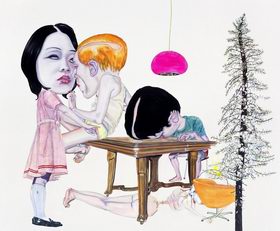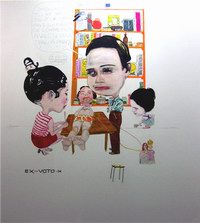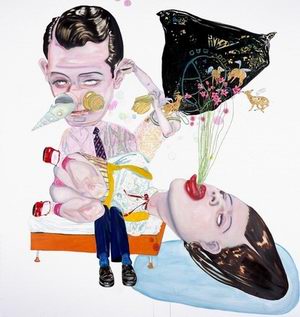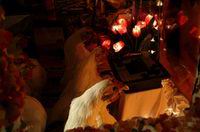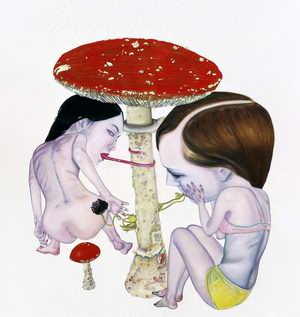Léopold Rabus
|
A girl clad in a pink
dress, black patent leather shoes and white socks – the very essence of
innocence, yet her face is the face of a grown-up woman. Her skin
reflects the bluish paleness of a porcelain doll’s enamel coating just
as does the boy’s, sitting in front of her in children’s underwear,
crooked and fending off the touch of the child-woman whose hand is
fumbling with his panties. At the table, a second boy has sunken down,
emaciated, his distorted fingers digging into the table top that affords
no hold. The figure below, half woman, half skeleton, her face buried
behind a designer chair, seems to be grasping for something, trying to
move forward, but eventually staying bound in her half dead body. |
|
The series „Ex-Voto“, whose title refers to the tradition of votive pictures dating back to late medieval Italy, depicts this persiflage especially well. A votive was – and is – a sacrifice of petition or gratitude for a saint that was offered at a place of worship by the suppliant and thereby made the vow public. These votives traditionally include a direct or attributive representation of the appealed saint, a depiction of the votant, the reason for the votation and the inscription “ex voto”.
|
Rabus seizes this
tradition and renders it absurd. Behind the sweet façade of shimmering
colours the protagonists’ quibbling meanness reveals: Around the girl on
the kitchen table with a bone stuck in her throat as if she were a comic
dog, two neatly dressed figures discuss the possibility of redeeming her
from her misery with a butter knife. A small icon of Maria Eleusa, the
pitiful Virgin Mother, with the crowned infant Christ on her arm
accentuates the theme of the painting which in contrast denotes the idea
of pity to an existentialist and lethargic perversion of itself, as if
accompanied by a regardless shoulder shrug. The spectator stands in
front of Rabus’ votives with mixed emotions between fascination and
disgust. |
|
With the use of real dark hair, the surface of the painting receives a haptic quality that stands in harsh contradiction to the glittering colour of nail polish. Together with the empty eyes and enormous heads reminding of children’s drawings, it evokes very ambivalent feelings. The emphatic innocence and naivety, the unconsciousness about common concepts of good and evil immanent in the figures of Léopold Rabus constitute a similarly eerie effect as does the motive of the twin sisters in Stephen King’s “Shining” – intuitive, unsettling and in a way not of this world.
|
|
A similarly
idiosyncratic iconography unfolds in the series „Scène Sainte” from
2004. “I try to capture the very moment when the soul – voluntarily or
not – leaves the body”, Rabus notes on these works. Returning motives
such as the fawns, not in last instance characterised through Disney’s
adaptation of Salten’s lively “Bambi” as idyllic and free of sin, or the
flower symbols originating in baroque iconography and now blossoming out
of the figures’ mouths and noses, conjure in their different contexts a
novel semiotic that abates like a veil over usual connotation. Whilst
winged fawns whir around devoured anemones in one painting, they are
gorged in the next or drink out of the sacred tears of those left behind
in yet another. |
The fairytale world from untroubled childhood years is broken, the idyll destroyed by the protagonists’ averting their eyes from one another. Their salacious poses unmask the spectator as voyeur, make him accomplice. As in the earlier series, the cheerful colours of the lovingly patterned clothes deceive the pictures’ philosophical-religious content and thereby quip on their own message: “The Man lives on his knees, condemns or praises god, a tree, a bottle, before finally laying down to his last rest: A lowly way of addressing what he does not understand.”
|
The subtle
irony with which Léopold Rabus covers exaggerated devotion is taken to
culmination in his video “L’Eau du Guide” (“the leader’s water”): A
preacher clad with a dark brown summer dress gathers a herd of chicken
around him to whom he explains the beauty of nature to illuminate their
souls. The inspiration for this video, the young artist found in Daniel
Meurois’ book “Stories of an Astral Traveller“ that tells the story of a
man travelling by meditation to a parallel world, where in a kitschy
setting he finds a spiritual leader with an entirely blue head. “That
small book made me laugh and moved me. Its vague cynicism animated me to
produce the short film”, Rabus comments. Following the film, he carries
this “vague cynicism” to the extremes and erects a shrine for the leader:
In a frosted gingerbread house adorned with marzipan piglets he gathers
the (stuffed) chicken around a fairy-light-draped devotion picture lined
with landscape photos strongly reminding of postcards (Gingerbread House,
2004) |
|
|
|
In his latest work –
the series “Les Oiseaux” (“The birds”, 2005) and “Champignons” (“Mushrooms”,
2005), the mass of information is reduced in comparison to his earlier
paintings and the action presented in reduced but no less complex
constellations. The balanced compositions whisk away the viewer to a
world of insect- like meandering bodies appearing both fragile and
menacing in their scarce garment. |
|
© Katharina Klara Jung, 2005 |
